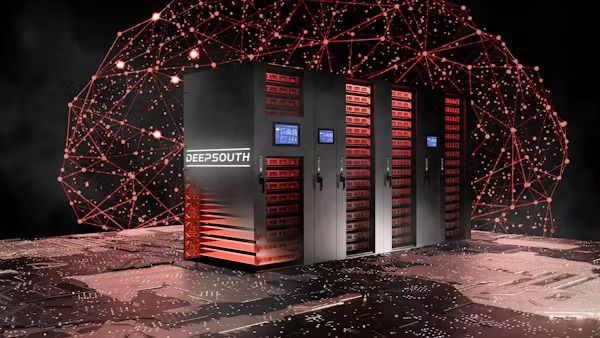NEW SCIENTISTS TECHNOLOGY
NEWSCIENTISTS
In 2024, a supercomputer capable of simulating the full human brain will turn on
a supercomputer capable of simulating the full human

Australian researchers have projected that a supercomputer set to go online in April 2024 will outperform the anticipated rate of processes in the human brain. With its 228 trillion operations per second capacity, the machine is known as DeepSouth.
It is the first supercomputer in history to replicate, at the scale of the human brain, networks of neurons and synapses—essential biological components that comprise our nervous system.
DeepSouth is part of a computing paradigm called neuromorphic computing, which attempts to emulate the biological functions of the human brain. The International Centre for Neuromorphic Systems at Western Sydney University will serve as its home base.
Our brain is the most sophisticated computer we are aware of. The brain can rival the world's most powerful supercomputers by dividing its computational capacity across billions of microscopic units (neurons) that communicate with each other through trillions of connections (synapses), all using the same amount of energy as a fridge lightbulb.
On the other hand, supercomputers often require a lot of room and electricity to operate. The Hewlett Packard Enterprise Frontier, the most powerful supercomputer in the world, is capable of little more than one quintillion operations per second. It uses 22.7 megawatts (MW) to operate and has a surface area of 680 square meters (7,300 sq ft).
Our brains weigh only 1.3–1.4 kg and can process the same amount of information every second with just 20 watts of power. Neuromorphic computing seeks to solve this remarkable efficiency among other things.
Transistors at the boundaries
John von Neumann, a mathematician and physicist, published a description of the Electronic Discrete Variable Automatic Computer (Edvac) on June 30, 1945. This essentially sums up what a modern electronic computer is.
The underlying framework developed by von Neumann over eight decades ago is shared by my smartphone, the laptop I'm using to write this essay, and the world's most powerful supercomputer. Each of them has its own unique processing and memory unit, where a processor uses memory to calculate instructions and store data.

Moore's Law, which dates back many decades, states that a microchip's transistor count quadrupled roughly every two years. Due to this, our computers are now more affordable and smaller.
Transistor sizes are now getting close to the atomic scale, nevertheless. Excessive heat generation and a phenomena known as quantum tunnelling, which obstructs the transistors' ability to operate, are issues at these small scales. Transistor miniaturization will finally come to an end due to this slowing down.
Scientists are investigating novel computing strategies to address this problem, beginning with the human brain, which is a potent computer that is concealed inside each of us. The computer model proposed by John von Neumann does not describe how our brains function. They lack discrete memory and processing sections.
Rather, they function by establishing connections between billions of nerve cells, which exchange electrical impulses that carry information. A connection known as a synapse allows information to be transferred from one neuron to the next. The brain's network of synapses and neurons is adaptable, efficient, and scalable.
Thus, memory and computation are controlled by the same neurons and synapses in the brain, unlike in a computer. Researchers have been working on this paradigm since the late 1980s, hoping to apply it to computers.
Life imitating
The foundation of neuromorphic computers consists of complex networks of basic processors that function similarly to the neurons and synapses in the brain. This has the primary benefit that these devices are "parallel" by nature.
This implies that almost every processor in a computer has the capacity to function and communicate with every other processor at the same time, much like neurons and synapses do.
Additionally, the energy consumption is orders of magnitude lower since individual neurons and synapses conduct extremely basic computations compared to typical computers. Despite the fact that synapses are frequently thought of as memory units and neurons as processing units, they really contribute to both processing and storing. To put it another way, the data is already there where the calculation needs it.
As a result, the brain processes information more quickly overall since memory and processor are integrated, unlike in traditional (von Neumann) computers, which slow down processing. However, it also avoids the need to use a significant amount of energy and execute a specialized process of accessing data from a primary memory component, which occurs in conventional computer systems.
DeepSouth is mostly inspired by the ideas we just discussed. There are more neuromorphic systems in use right now than this one. The Human Brain Project (HBP), which is supported by an EU program, is noteworthy. The Human Brain Project (HBP) ran from 2013 to 2023 and produced the Heidelberg, Germany-based BrainScaleS system, which simulates the function of neurons and synapses.
BrainScaleS is able to replicate the "spike" that occurs when an electrical impulse passes through a neuron in the human brain. Because of this, BrainScaleS would be a perfect fit to study the mechanics of cognitive functions as well as the mechanisms behind neurological and neurodegenerative illnesses in the future.
Because neuromorphic computers are designed to resemble real brains, this might be the start of a revolution. They provide economical and sustainable processing power and enable researchers to assess neural system models, making them a perfect platform for a variety of uses. They may contribute to new developments in artificial intelligence as well as improve our knowledge of the brain.
More design inspirations
New Scientists Technology
Stay up-to-date with the latest advancements in technology with New Scientist. Explore cutting-edge innovations, discoveries, and trends shaping the future.
Contact Us
We will get back to you as soon as possible.
Please try again later.




